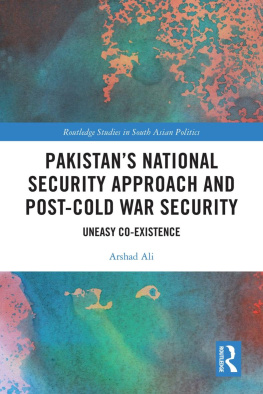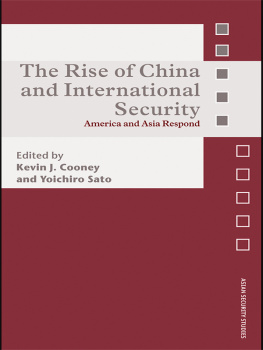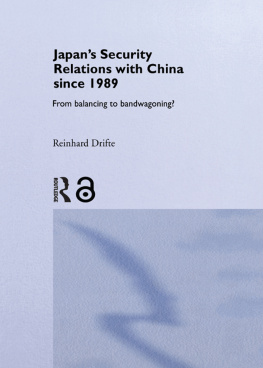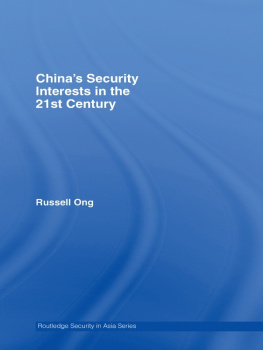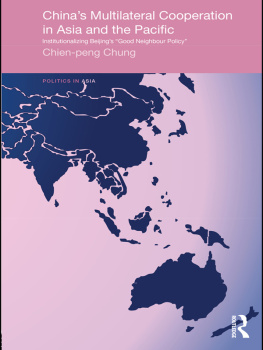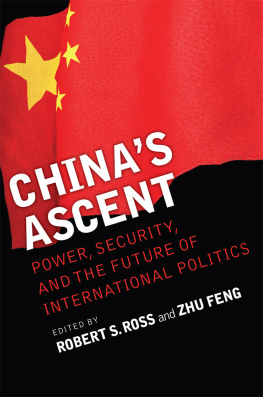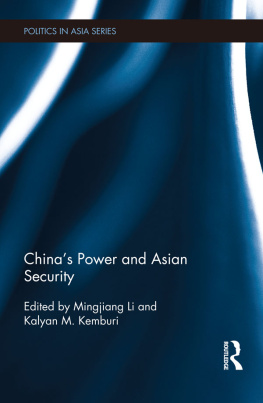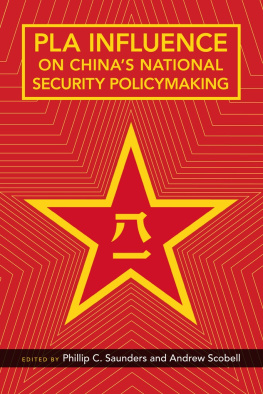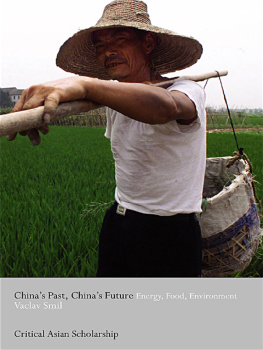First Published in 2002
by Curzon Press
Published 2013 by Routledge
2 Park Square, Milton Park, Abingdon, Oxon OX14 4RN
711 Third Avenue, New York, NY, 10017, USA
Routledge is an imprint of the Taylor & Francis Group, an informa business
2002 Russell Ong
All rights reserved. No part of this book may be reprinted or reproduced or utilised in any form or by any electronic, mechanical, or other means, now known or hereafter invented, including photocopying and recording, or in any information storage or retrieval system, without permission in writing from the publishers.
British Library Cataloguing in Publication Data
A catalogue record of this book is available from the British Library
Library of Congress Cataloguing in Publication Data
A catalogue record for this book has been requested
ISBN 13: 978-0-700-71558-9 (hbk)
I wish to thank Eric Grove, Noel OSullivan, Tim Huxley, Michael Yahuda, Christopher Coker and Rosemary Gosling for their assistance. Special thanks must also be given to the library staff at the University of Hull and the London School of Economics who have all provided the necessary facilities to carry out my study.
The aim of this book is to analyse Chinas national interests, using a wider definition of security, in the post-Cold War era. This is congruent with the current Chinese emphasis on comprehensiveness (quan mian hua). In particular, this book aims to incorporate nonmilitary elements of security, such as political security and arguably, the most important of all, economic security. It will be argued that the adoption of a broader definition of security is vital, for only by doing so will it enable us to gain a better understanding of Chinas security interests in the post-Cold War era. This study is in itself important, as Chinas role in international relations is increasing over time.
Geographically, the book focuses on Northeast Asia although certain issues relevant to the central argument of the book, such as human rights and the collapse of communism, are also included. This introductory chapter is divided into two sections. The first surveys the post-Cold War security environment in Northeast Asia, which forms part of the milieu in which Chinese policymakers assess their security interests. The second section explains the structure of the book and the assumptions, also setting out the research methodology employed.
The context: The post-Cold War era and Northeast Asia
After the Cold War ended, Chinas security agenda was naturally affected and there is in general a need to reassess the new security patterns and structures taking shape in the international system. This means that Chinas security policymakers have to react to changes both to the system in Northeast Asia and, indeed, to the entire international system. For our purposes, Northeast Asia may conveniently be regarded as a geographical area that includes Japan, China, South Korea, North Korea, Mongolia, Taiwan and the far eastern portions of Russia. Historically, this has always been a region full of contradictions and conflicts. During the twentieth century, Northeast Asia experienced three wars, the 1905 Russo-Japanese War, the 19371945 Sino-Japanese War and the 19501953 Korean War. In addition, the Cold War confrontation was also fought out in Northeast Asia.
The Cold War in Northeast Asia manifested itself in the form of two adversarial security alliances. One was formed by China, North Korea and the Soviet Union; the other by the United States, Taiwan, South Korea, and Japan. Each of these security alliances was formed through bilateral treaties among the different parties and this structure was maintained for about 40 years, from the early 1950s to the late 1980s. Although there were some changes during those years, the overall security structure in Northeast Asia did not undergo any fundamental changes. In addition, the classification of the United States as a Northeast Asian power lies in the fact that, although situated outside, America has a strong influence over the region and plays an important role in shaping the regional strategic environment. Therefore, Chinese perceptions of the American threat have to be assessed in this book, as this will bring additional insights on Chinas security interests as a whole.
Since the ending of the Cold War, Northeast Asia has become an even more important region for analysts and policymakers alike. Today, the geostrategic and geoeconomic importance of Northeast Asia cannot be overstated, for this is a sub-region of Asia where four of the worlds five recognised centres of power, the United States, Russia, China and Japan meet and interact; where permutations of bilateral, trilateral and quadrilateral power games are played out on multiple chessboards with all their complexities and shifting configurations. Northeast Asia is also the only region where the Cold War has ended only partially, contrary to the more synchronised rhythms and expanding circle of great power co-operations taking place elsewhere, such as in Europe.
For China, Northeast Asia has consistently been critical to its security interests in recent years. Apart from Europe, all of the most important forces that interact internationally with China are gathered in this region. For China, this is its backyard. History shows that China has fought several wars to maintain its security in Northeast Asia. Some campaigns were successful, others were not. China fought against Japan twice, in the 18941895 and 19371945 wars. Beijing intervened when the onset of the Korean conflict in 1950 brought American military forces to Chinas northeastern doorstep, within easy reach of its capital. In the aftermath of the Sino-Soviet split, China fought a small-scale border war along the Ussuri River against the Soviet Union in 1969. Although the use of force as a means to protect its security interests is increasingly unlikely today, it is true to say that China still faces some regional powers in the Northeast Asian region which may pose threats to its security.
For China, Northeast Asia, which constitutes part of the larger Asia-Pacific region, is vital for its comprehensive security. Chinese President Jiang Zemin has stated that:
China is now going all out for economic development and this requires not only domestic stability but also a stable international environment. We attach great importance to political stability in the Asia-Pacific region, because this constitutes an important condition for ensuring economic development in the region.
This statement essentially sums up Chinas security agenda in the post-Cold War era. China seeks economic and political security, in addition to military security as it continues on the road to global power status in the twenty-first century. The political and economic aspects of security are of vital importance to China and constitute central subjects of this book.
A focus on Northeast Asia also coincides with Chinas attempt to refocus its diplomacy on the Asia-Pacific region as a whole. China wants to build up its power base in Northeast Asia before eventually emerging as a truly global power. This trend has been reinforced by the international repercussions arising from the 1989 Tiananmen Incident. Furthermore, developments in Eastern Europe and the Gulf War in 19901991 have indicated the need for China to adjust its foreign policy, with an emphasis on improving relations with its Asian neighbours, as communism crumbled on a large scale and the United States dominated international security issues after the Cold War ended. Since 1989, China has begun to focus on surrounding area (




